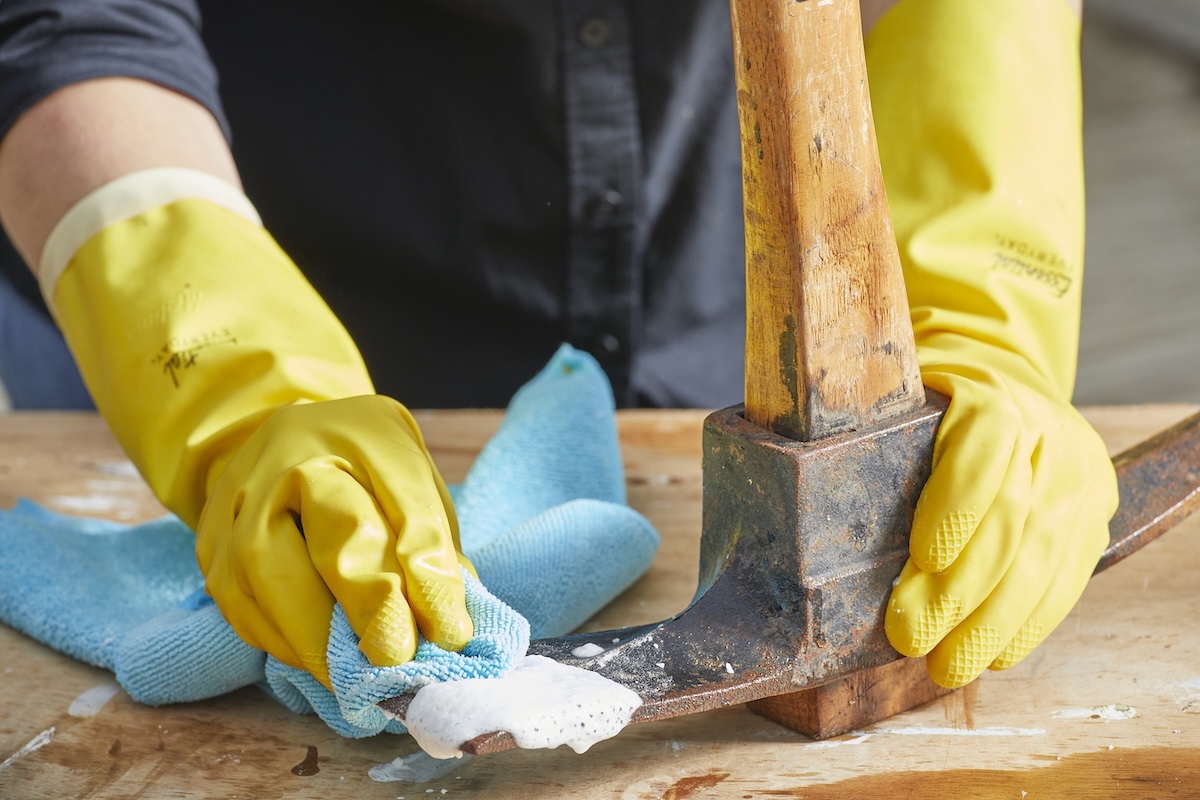

We may earn revenue from the products available on this page and participate in affiliate programs. Learn More ›
Rust is a common household enemy, rearing its ugly orange-brown head anywhere from the kitchen utensil drawer to the workshop tool chest. Although it poses no health risks on its own, anyone looking for ways to remove rust from metal is far from alone. There’s no shortage of store-bought rust removers on the market, though many contain toxic ingredients that can irritate your skin, lungs, and eyes. Before resorting to these potent solutions, first try sanding, and raiding your fridge and pantry for effective (and perhaps surprising) homemade rust removers like ketchup and potatoes.
No matter which technique you try, any effort to remove rust should begin the same way: by using pliers, screwdrivers, or wrenches—and, if necessary, lubricant—to remove screws and other fasteners.
Sanding
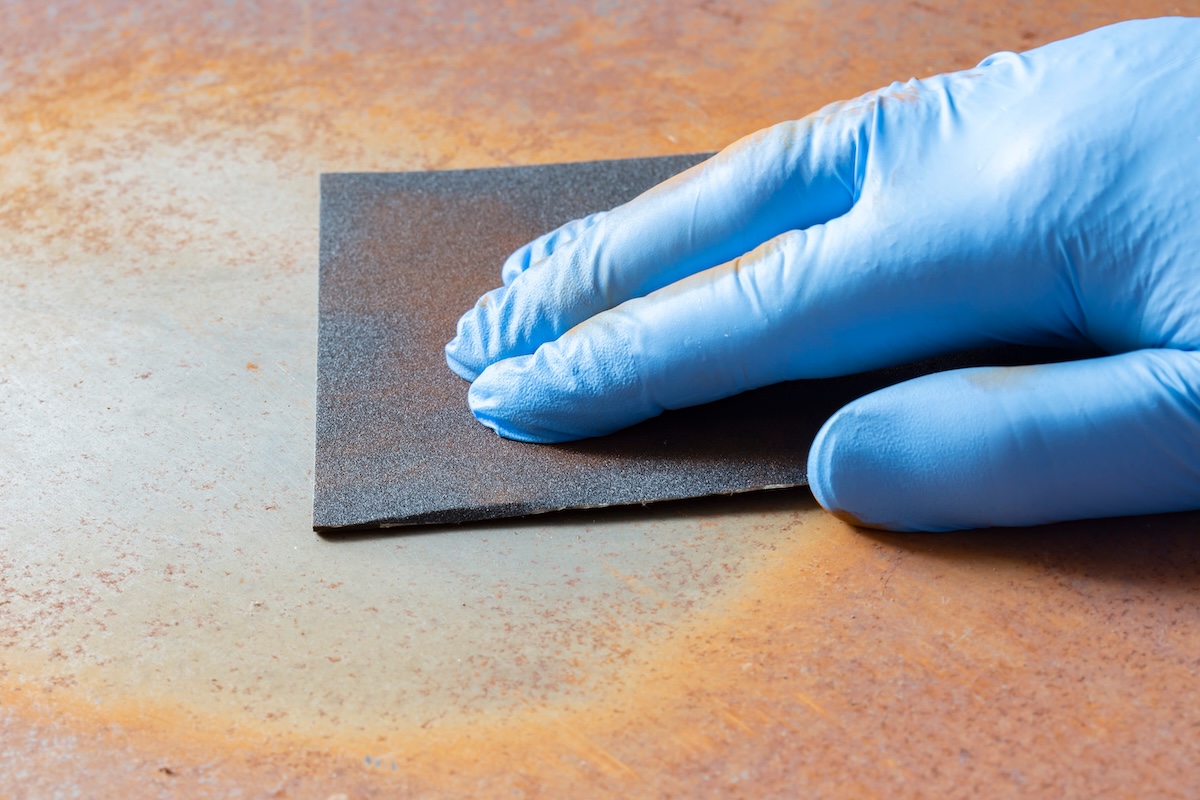
SUPPLIES
Coarse-grit sandpaper
Fine sandpaper
Steel wool
Electric drill with wire wheel
If you want to remove rust from metal marred not only by corrosion but also a great deal of flaking paint, there’s really no substitute for good old-fashioned elbow grease. Sanding the surface of the object with sandpaper or steel wool (or even a scouring pad) often does the trick, so long as the rust is light. Scrape first with a coarse-grit paper, making sure you remove all pockmarks before finishing with a finer grit to smooth out grooves.
For heavier rust buildup, try an electric drill outfitted with a wire brush. Alternatively, if you have access to one, use a grinder, but do this carefully. Keep the grinding wheel, stripping disc, or flap disc moving on the object at all times, or you’ll risk causing damage worse than rust.
Our recommendation: Black+Decker LDX120C 20V MAX Cordless Drill/Driver at Amazon for $70.64
The Best Bang for the Buck pick in our tested guide to the best cordless drills, the Black+Decker 20V Maxis intended for basic around-the-house drilling and driving, and it does that exceptionally well. It is a fine, economical choice for a wire brush attachment for sanding.
Vinegar
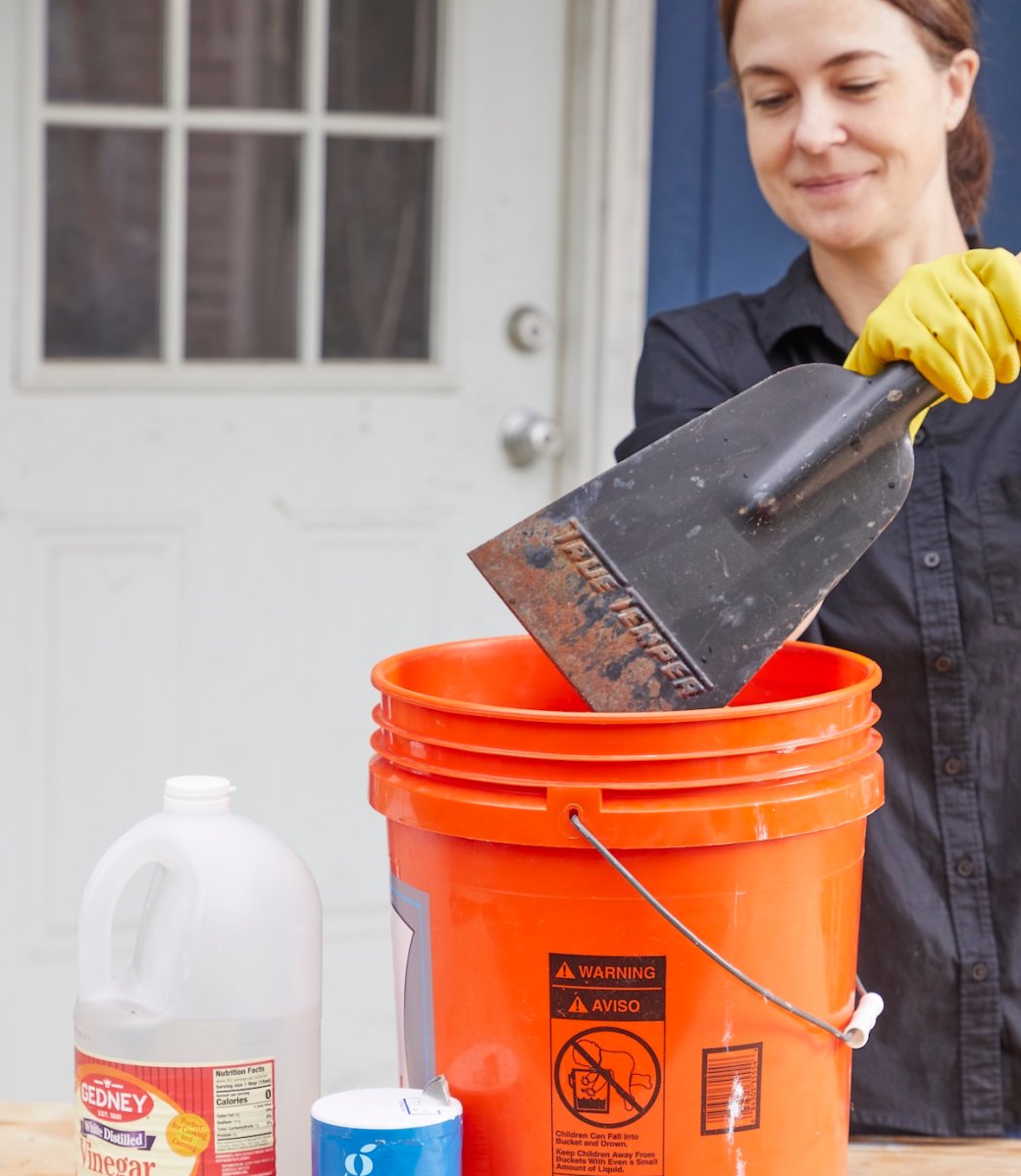
White vinegar and baking soda are a well-known duo for their efficacy and flexibility as household cleaners, and they can even be used for removing rust from metal when combined with salt. This rust removal method is easy but takes time, and it’s ideal for cleaning several rusted metal items, such as a kitchen utensil set, at once.
SUPPLIES
5-gallon bucket
White vinegar
Table salt
Gloves
Baking soda
Microfiber cloths
Step 1: Prepare rusted metal objects before soaking them in a salt and vinegar mixture.
In a large bucket or tub, pour ½ cup of salt into ½ gallon of distilled white vinegar. Mix the two together until the salt fully dissolves. Disassemble any rusted items that have removable nonmetal parts, such as wood or plastic handles. Add the rusty metal pieces to the vinegar solution, and allow them to soak for up to 12 hours.
Step 2: Remove and rinse metal after soaking.
Put on disposable or dishwashing gloves, transfer the metal items to the sink, and dispose of the vinegar mixture down the drain with the faucet running. Thoroughly rinse each piece before returning them all to the bucket or tub.
Step 3: Briefly soak the pieces in a baking soda and water mixture.
Pour ½ gallon of water and ½ cup of baking soda into the container and mix until the baking soda dissolves. Allow the metal to sit in the mixture for about 10 minutes before once again transferring each piece to the sink and dumping out the water.
Step 4: Wipe down, rinse, and dry the metal.
With a clean cloth, thoroughly wipe down each metal surface. Next, rinse them all under warm water. Finally, fully dry the cleaned metal with dry microfiber cloths.
Lemons
Another popular natural cleaner, lemons can also eliminate light-to-moderate cases of metal rust. Combined with the abrasiveness of everyday table salt, these citrus fruits are as effective in cleaning and rust removal as they are delicious in zesty dishes and refreshing beverages.
SUPPLIES
Table salt
Lemons
Abrasive pad (optional)
Microfiber cloths
Step 1: Coat the rusted area(s) with salt and lemon juice.
For pans, hand tools, and other small metal items, lay the piece being cleaned in the sink or on a suitable work surface with any rust spots facing up. Lightly sprinkle salt onto the reddish-brown spots. Then, squeeze a cut lemon or use a cloth to wipe some lemon juice directly onto those problem areas.
Step 2: Allow the lemon juice and salt to sit on the metal surface.
Let the lemon juice and salt soak on rusted metal for up to two hours. When removing rust from especially rusty tools or hardware, you may need to lightly scrub the mixture into the metal surface before allowing it to soak.
Step 3: Wipe, rinse, and dry the surface completely.
Use a clean cloth to wipe off the lemon juice and salt from the metal, and thoroughly rinse the surface under the faucet or with a damp cloth to remove any remaining residue. If the treated rust spots remain but have lessened in size or color, repeat these steps until all of the rust disappears. Once you’re satisfied with the results, fully dry the clean metal surface with a dry microfiber cloth.
Potatoes
If you have some spare spuds in the pantry, you’re in luck: Raw potato contains oxalic acid, making it a natural rust remover. This method is especially helpful if you’re looking for how to get rust off cast iron pans. You can even stab the rusty metal blade of a kitchen knife into a potato and let the oxalic acid work its magic for a few hours before skipping ahead to Step 3 below.
SUPPLIES
Russet potatoes
Dish soap
Table salt or baking soda
Microfiber cloths
Step 1: Cut a potato in half, and coat the cut end with soap and salt.
Slice a potato in half—lengthwise for larger rusted surfaces, horizontally for smaller rust spots. Apply and rub in a small amount of liquid dish soap to the cut end. Follow up with a light dusting of salt or baking soda to cover the soapy surface.
Step 2: Rub the cut end of the potato onto the rusted surface.
Using moderate pressure, press the cut end of the potato against the metal and rub it into any visible rust spots. Continue until the rust diminishes or disappears.
Step 3: Thoroughly rinse and dry the metal.
Fully rinse the metal surface under the kitchen faucet or with a damp cloth. Dry the clean surface with a dry microfiber cloth.
Ketchup
While searching the kitchen for what removes rust unsurprisingly turns up several common cleaning ingredients, ketchup is likely the last condiment most people would expect to double as a DIY rust remover. Combined with washing soda, though, ketchup’s vinegar content and unique viscosity make it an effective choice for small spots of rust.
SUPPLIES
Spray bottle
Ketchup
Washing soda
Paper towels (optional)
Microfiber cloths
Step 1: Mix washing soda and water in a spray bottle.
Combine water and washing soda (aka sodium carbonate, a common homemade laundry detergent ingredient) in a spray bottle, following the washing soda’s label instructions for household use; the approximate ratio may be around 2 cups of water for every 2 tablespoons of washing soda. Vigorously shake the rust remover spray mixture.
Step 2: Apply the mixture and ketchup to the rust.
Spray a liberal amount of the washing soda solution onto each rust spot. Then, dispense a dense layer of ketchup on top. Allow it to sit on the metal surface for up to two hours.
Step 3: Rinse and dry the metal surface fully.
Use paper towels or cloths to wipe away the ketchup and washing soda before thoroughly rinsing the metal with tap water or one or more damp cloths. Completely dry the surface with a clean microfiber cloth.
Cream of Tartar
If you enjoy making desserts, or you DIY your own drain cleaner, you probably already recognize the value of keeping cream of tartar stocked in the pantry. What you may not know, however, is that this baking essential can also be used as a homemade rust remover when combined with baking soda and hydrogen peroxide.
SUPPLIES
Cream of tartar
Baking soda
Hydrogen peroxide
Microfiber cloths
Step 1: Mix cream of tartar, baking soda, and hydrogen peroxide in a bowl.
Combine equal parts cream of tartar and baking soda in a bowl. Stir in a splash of hydrogen peroxide at a time until the mixture reaches a toothpaste-like consistency.
Step 2: Apply the paste to rusted metal and let it sit.
Slather the paste onto any visible rust spots on the metal, and rub it into the surface with a microfiber cloth. Allow it to work away at the rust for at least an hour.
Step 3: Rinse and fully dry the metal surface.
After wiping away the cream of tartar paste with a clean cloth, rinse the metal with a damp cloth or under tap water. Fully dry the surface with a dry microfiber cloth.
Rust Converter
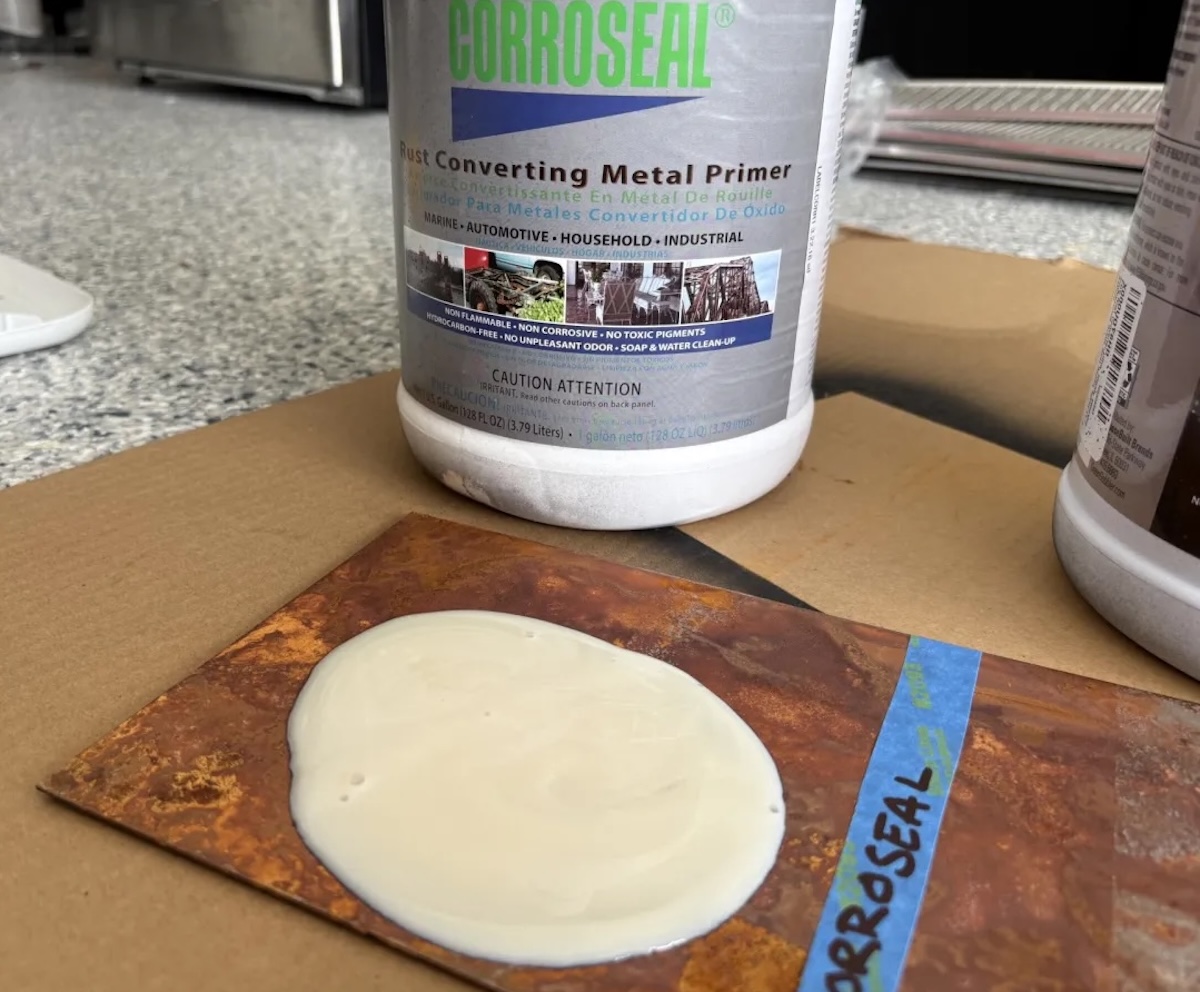
SUPPLIES
Wire brush
Paint brush
Liquid or spray rust converter
Available for purchase in liquid or spray forms at most home improvement centers, rust converters work wonders on iron or steel. Handling the product is a cinch. First, use a wire brush to scrape off any rust dust or flaking paint on the item you wish to clean. Next, apply the rust converter with a paint brush (if you’ve chosen the liquid) or directly (if you’ve opted for the spray). What happens next is a miracle of chemistry: The rust transforms into a black substance, one that prevents further corrosion and can be painted over to achieve a finish that seems brand new.
Our Recommendation: Corroseal Water-Based Rust Converter (1 gallon) at Amazon for $61.94
The best overall performer in our tested guide to the best rust converters, Corroseal saves time by both neutralizing rust and priming metal surfaces for paint. It’s also eco-friendly when compared to sandblasting or using harsh chemical removers.
Chemical Rust Remover
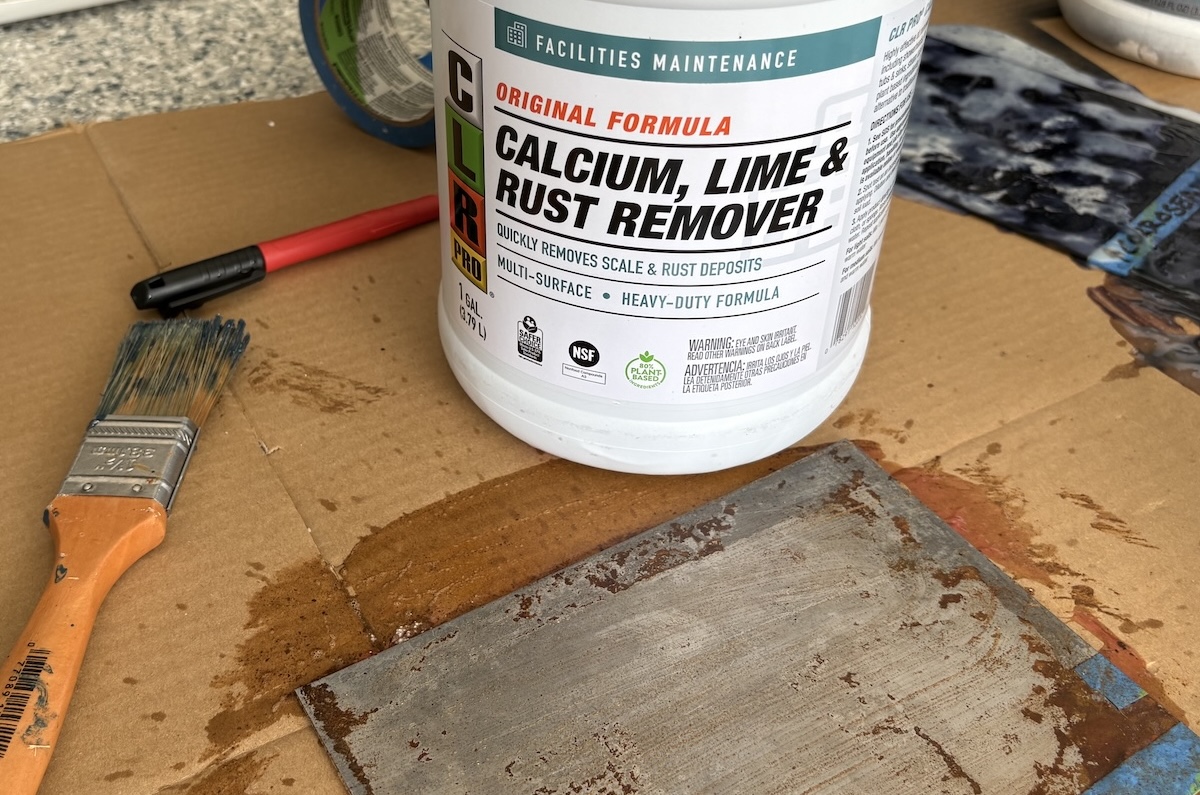
SUPPLIES
Safety goggles
Rubber gloves
Paint brush
Putty knife
Rags
Rust remover
Take tremendous care when using commercially sold chemical rust removers; these powerful solutions contain either hydrochloric or phosphoric acid. Do this type of work only in well-ventilated spaces, and be sure to wear protective eyewear, rubber gloves, and clothing that covers your arms and legs.
Want to remove rust from a small metal object? You can fully immerse it in the rust remover, letting it soak one to three hours for light rust, overnight for heavy rust. If you are removing rust from a larger, more unwieldy object, consider using a remover in gel form. Once applied, different products take different amounts of time to be effective, so read the manufacturer’s directions closely. In cases where a significant amount of rust has built up over time, be prepared to apply several courses of the chemical before seeing the desired results.
Our Recommendation: CLR Pro Calcium, Lime, and Rust Remover (1 gallon) at Amazon for $24.98
The Best Multipurpose pick in our tested guide to the best rust removers, this liquid formula combines lactic and gluconic acids, which are less caustic than some harsher acid blends. It is inexpensive, works very quickly, and creates little mess and odor.
To learn more about removing rust, check out our video below.









